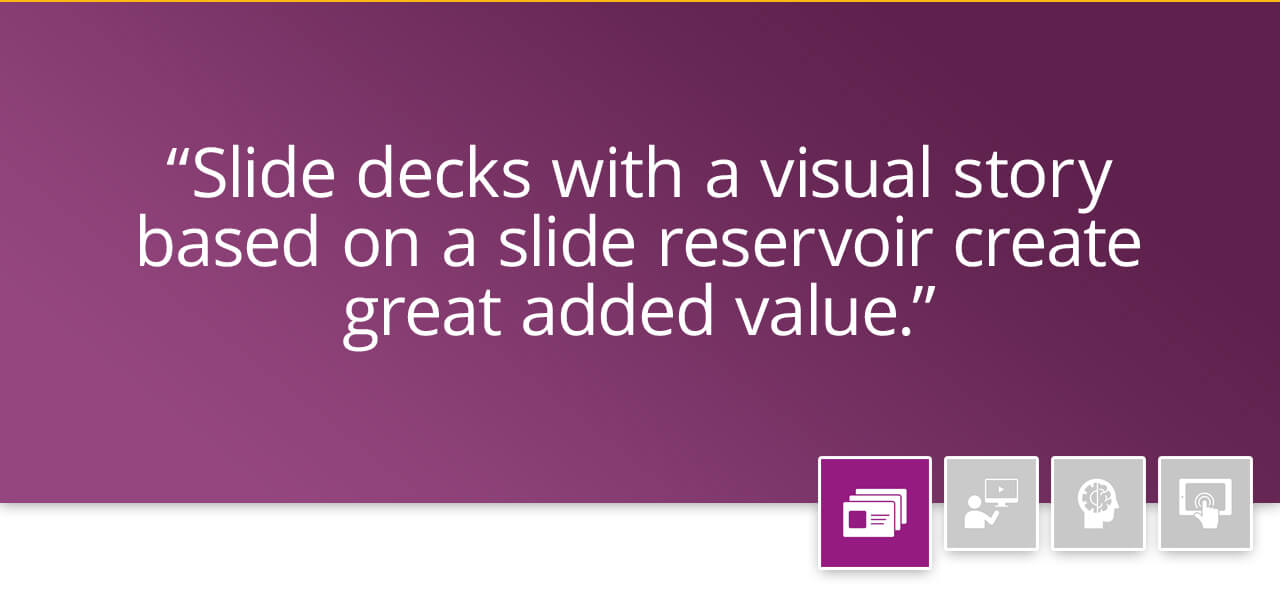How to transform a boring slide deck into an exciting scientific visual story
It’s true. PowerPoint presentations have a bad reputation in the pharmaceutical and biotech industry. All too often, they’re boring and stuffed full of information that nobody can remember, or else so badly designed that they leave audiences bewildered. And yet every day countless new bad slides are created for yet more yawn-inducing presentations.
The sheer number of slides is also staggering. I sometimes marvel at just how many slides are thrown at MSLs to use in talks with HCPs or slapped together to use for training. Of course, there’s always a lot of ground to cover, and the team needs to make sure they know a treatment and the therapeutic area inside and out. But if the audience can’t even make it through the first ten slides, there’s little chance the next hundred are going to make an impact.
Then there are the slides themselves that max out an audience’s cognitive load with avoidable mistakes like:
- cramming too much information onto each slide,
- using too many different fonts,
- using miniscule font sizes,
- showing images with inconsistent visual styles that don’t match the overall design of the slide deck (if there is one), and
- crowding out every bit of space.
Sadly, these are mistakes made even by scientific-communication agencies hired to develop slide kits. It’s important to know that many sci-comm agencies lack expertise in graphic design and didactics. The consequence: bad slides that leave your communication goals just out of reach.
Slide decks with a visual story based on a slide reservoir create great added value
Many of my customers now want concise decks that tell a clear scientific story with as few as 10 or 20 slides. They rightly ask themselves how much information their target group can realistically absorb. And they often find the answer is less than they would hope for. The solution: visual storytelling slide decks that build on existing slides, focus their content, and use exciting and dynamic visuals to guide the audience through the story. It might seem like a daunting task, but I’ve helped many customers over the years take this journey.
To get there, you need to answer the following questions:
- How should the story be told?
- What information is actually important for understanding the story?
- Which key messages should the audience remember in the end?
Once the essential elements of the story are clear, you have to carefully pick out those slides that are crucial for communication from your massive reservoir of slides. Here, you also need to resist the temptation to put more information in the deck than needed. Most of the time you are dealing with redundant facts that do not contribute to the understanding of the actual story. The law of parsimony applies: don’t use two slides to make a point if one slide will do the job. Nonetheless, at this stage of a project you will probably still have about 20% more slides than you want to have at the end. That’s because with a few simple tricks in the next steps, you can dramatically condense the information on each slide.
A good visual story gives the slides structure
A good visual story starts with the title of each slide. It’s such a simple point, but all too often, people use just a word or phrase for a headline like “epidemiology” instead of a strong key message like “cases increased over the past ten years.” Making your headline into a key message gives the target group a quick summary of the slide. They get the point you want to make immediately. In other words, imagine your audience can only remember one fact from the slide. Then take that fact and put it in the headline.
On the other hand, any further text on the slide should be reduced to the bare minimum. Let the visuals do the explaining. Strong visual elements offer the greatest potential for condensing information. They provide a clear entry point into the slide and guide the eye. Visuals can range from minimalistic icons to sleek infographics and from detailed technical illustrations to elaborate animated sequences.
Consistency throughout the entire slide deck is also crucial for a good visual story. In general, this is achieved by a good slide master in which the essential elements such as fonts, font sizes, arrangement of logos, structure, and presentation of scientific charts etc. are clearly defined. One basic rule: never use more than three different font sizes. Smooth fade-ins and fade-outs, a sequential structure, and harmonious transitions from slide to slide make it more pleasant for the target group and give your presentations a cinematic feel.
How you can get the most value from the slides you have
Transforming a boring slide deck into a punchy visual story offers tremendous value. And it only takes a few small yet decisive steps, which you can take alone or alongside your partnering agency.
In my online workshop, I will explain how to apply these steps successfully and how to turn basic slides into scientific visual stories that make a splash. Just pick a timeslot that would work best for you here, and let’s get started telling your story!
Do you have problematic slides in your deck?
If you are a leader in pharma or biotech, send us the most problematic slide in your deck: we will rework it and come up with suggestions for improvement. This service is free of charge, with no obligation!

Stefan Wolf is one of the founders of CAST PHARMA, a scientific visual storytelling agency that develops engaging slide decks, animated videos, learning and training solutions, and interactive tools for pharmaceutical and biotech companies.

